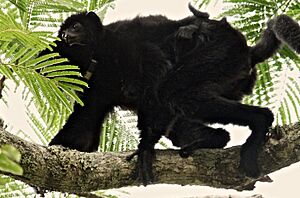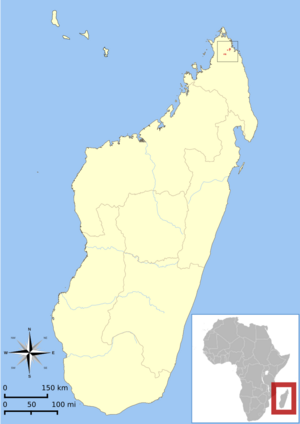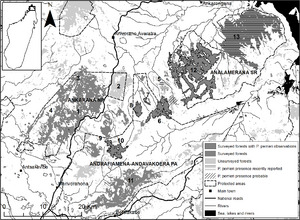Perrier's sifaka facts for kids
Quick facts for kids Perrier's sifaka |
|
|---|---|
 |
|
| Conservation status | |
| Scientific classification | |
 |
|
| Distribution of P. perrieri |
The Perrier's sifaka (Propithecus perrieri) is a type of lemur that lives only on the island of Madagascar. It used to be thought of as a smaller group of the diademed sifaka.
This sifaka lives in a very small area in northeastern Madagascar. Its home is in dry forests or forests that are a bit humid. Some of these areas are protected. The Perrier's sifaka is almost completely black. It is about 90 cm (35 in) long, and half of that length is its bushy tail. Female sifakas are usually a little bigger than males.
They move in small family groups through the treetops. They eat fruits, leaves, flowers, buds, and seeds. Each group has its own area, about the size of a football field, and they talk to each other with calls. The biggest dangers to this sifaka are losing its home and its forest breaking into smaller pieces. This happens because of slash-and-burn farming, collecting wood for charcoal, and cutting down trees. The International Union for Conservation of Nature says this animal is "critically endangered". This means it is at a very high risk of disappearing forever.
Contents
What Perrier's Sifaka Looks Like
This sifaka is usually between 85 to 92 cm (33 to 36 in) long. Its tail makes up about 42 to 46 cm (17 to 18 in) of that length. Its fur is almost entirely black, covering its whole body except for its face and ears. It has small eyes that face forward.
Perrier's sifakas weigh between 3.7 to 6.0 kg (8.2 to 13.2 lb). There isn't much difference between males and females, but females are usually a bit heavier on average.
Where Perrier's Sifaka Lives
The Perrier's sifaka lives in a very small part of northeastern Madagascar. It can be found between the Irodo River in the north and the Lokia River in the south.
Most of these sifakas live in the Analamerana Special Reserve. This area is managed by Madagascar National Parks. They also live in the Andrafiamena Protected Area, which is looked after by an organization called Fanamby. Some reports from many years ago said they were in the Ankarana Special Reserve, but this has not been confirmed recently.
Their home is in dry deciduous forests (where trees lose their leaves) and forests that are a bit humid. Each group of sifakas usually has a home area of about one hectare (about 2.5 acres).
What Perrier's Sifaka Eats
The Perrier's sifaka eats a diet similar to other sifakas. They mostly eat fruits, leaves, flowers, buds, and seeds. Sifakas are naturally good at eating plants because they have long digestive systems and special parts in their stomachs.
Sifaka groups do not fight with each other over food. They also rarely come into contact with other groups while eating.
What sifakas eat changes with the seasons. During the wet season, Perrier's sifakas spend most of their time (about 70% to 90%) eating fruits and seeds. But in the dry season, they spend most of their time eating leaves and flowers.
Perrier's Sifaka Behavior
Perrier's sifakas use different sounds to talk to each other. These sounds include warning calls. People have even heard them make a sound that sounds like sneezing!
Social Structure
Sifakas live in groups of two to six individuals. There is very little fighting between different groups. Also, groups rarely meet each other.
Their society is mostly led by females. This means females get to eat first. How they find partners and have babies has not been studied much yet.
Life Cycle
Perrier's sifakas have babies either every year or every two years, depending on the season. Baby sifakas grow slowly, even though there is a lot of food in Madagascar. However, their teeth develop quickly.
Scientists think this quick tooth development helps the babies become independent faster. This means the mother doesn't have to spend as much energy and time raising her young. About half of all baby sifakas do not live past their first birthday. Young sifakas become independent when they are two years old. Females can have their own babies when they are four, and males can when they are five.
Protecting Perrier's Sifaka
The Perrier's sifaka is one of the most endangered primates. This is because it lives in a very small area and there are not many of them. It is listed in CITES Appendix I, which means it is highly protected.
A plan to help save the Perrier's sifaka was made in 2012. This happened after a meeting of the International Union for Conservation of Nature's Species Survival Commission (SSC).
In the Analamerana special reserve, cutting down specific trees is still a big problem. However, in the Andrafiamena-Andavakoera protected area, the main problems are cutting down forests for slash-and-burn farming and making charcoal.
Because there are so few sifakas left and threats continue, we urgently need to know how many there are. We also need to stop their habitat from being destroyed. This requires a single plan for the whole region. The sifaka's natural home crosses three different protected areas. These areas are managed by different groups like Madagascar National Parks and Fanamby. Many different people are involved, like park services, governments, universities, and local farmers. So, saving the Perrier's sifaka needs a clear leader to make sure everyone works together.



